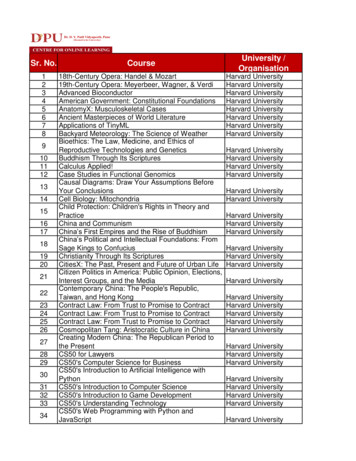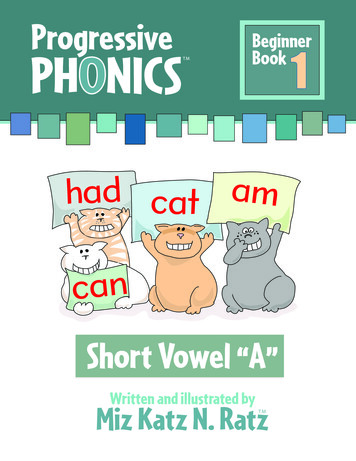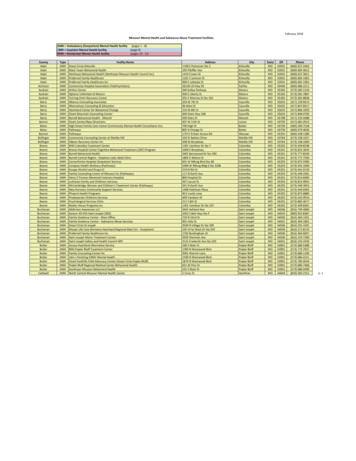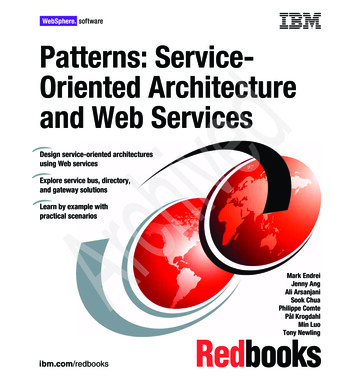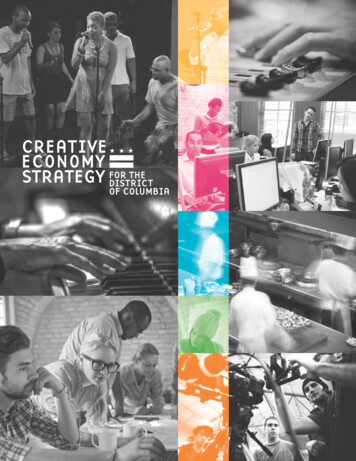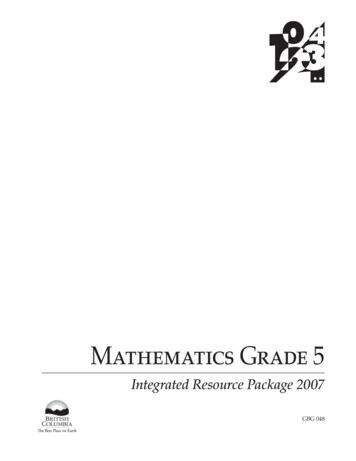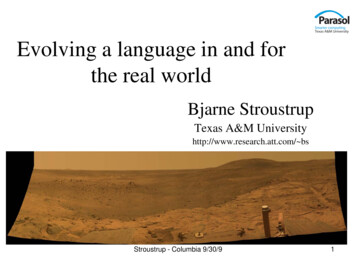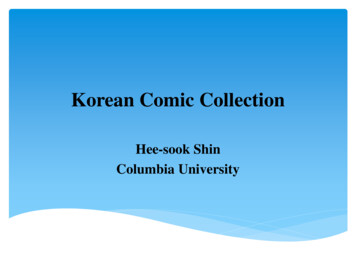
Transcription
Korean Comic CollectionHee-sook ShinColumbia University
Outline Brief Introduction of Manhwa Definition History Statistics Major publishers Manhwa Collection at CU Acquisition Cataloging Circulation Issues/Challenges Conclusion
What is „Manhwa‟ ? “Manhwa (만화)” is the term for Korean comics andprinted cartoons and has been used since 1923. 漫畫 (manhwa) – Korean comics 漫画 (manga) – Japanese comics 漫畫 (manhua) – Chinese comics “Taŭm ŏtchi (다음 엇지)” was used before„manhwa” Comics in North Korea are usually referred to as“Kŭrimchaek (그림책)”
History of Manhwa Emergence of Modern Manhwa (1909-1945) Development of Manhwa (1945-1970) Renaissance of Manhwa (1971-1999) New era of Manhwa (2000- )
Emergence of Modern Manhwa(1909-1945) Launched Korean newspapers and periodicals in late 19th& 20th century. Published Korea‟s first comic strip by Do-yŏng Yi(이도영), titled “Saphwa (삽화)” in “Taehan Minbo(대한민보)” in 1909.
Emergence of Modern Manhwa(1909-1945) Published comic strips by Dong-sŏng Kim (김동성)and Sŏk-chu An (안석주) in 1920s. Featured as a political satire with current affairs innewspapers. “Mŏngtŏngguri” by Suk-hyŏn No was the firstentertaining newspaper comic strip. Comics were published mostly in newspapers andchildren‟s periodicals.
Development of Manhwa(1945-1970) Launched & published various comic only magazinessuch as “Manhwa segye (만화세계)” Launched and published various genres such as romancecomics, fantasy comics, and sports comics Launched Rental shops “Taebonso (대본소) ( manhwakage or manhwabang (만화가게 or 만화방))” in 1958 Popular cartoonists in the era were Yong-hwan Kim(김용환), Sŏng-hwan Kim (김성환), San-ho Kim (김산호),Dong-u Sin (신동우), and Ki-dang Park (박기당).
Taebonso ( Manhwa kage orManhwabang)
“Kobau yonggam (고바우 영감)” bySŏng-hwan Kim (김성환)
Renaissance of Manhwa(1971-1999) Introduced the genre, adult comics such as “Imkkŏkchŏng(임꺽정)” and “Koindol (고인돌)” Jolly comics and romance comics were also boomed andcartoonists were Chang-dŏk Kil (길창덕), Mun-su Sin (신문수),and cartoonists of the romance comics were Hŭi-ja Ŏm (엄희자)and Ae-ni Min (민애니). A lot of comic magazines were published such as “IQ Jump”which led to the comic book market.
Renaissance of Manhwa(1971-1999)
Renaissance of Manhwa(1971-1999) Long narrative comicknown as graphic novelswere published and Hyŏnse Yi (이현세)‟s “Kongp‟oŭi ŏein kudan (공포의외인구단)” . Hyŏn-se Yi (이현세), Yŏngman Hŏ (허영만), Pongsŏng Pak (박봉성), Sangmu Yi (이상무) and Hui-jaeYi (이희재) were the maincartoonists.
New era of Manhwa(2000- ) Printed comic magazinesand books were shut downor were transformed intoonline comics, called“Webtoon” since 2000. Webtoon‟s formats areepisodic, sports and essaycomics and and Pul Kang(강풀)‟s “Sunjŏng manhwa(순정만화)” are examples.
New era of Manhwa(2000- ) Webtoons are provided through portals such asNaver and Daum, personal blogs and are mostlyavailable for free. Educational comics for children as well aspromotional series of comics have been publishedincreasingly. Cartoonist in the era are Pul Kang (강풀), Ho-minChu (주호민), T‟ae-ho Yun (윤태호), To-ha Kang(강도하), Yŏng-sun Yang (양영순), Sŏk Cho (조석),Il-gwŏn Ha (하일권).
Statistics of printed manhwaTotal Number of Korean Publications in 201214%Total New Title86%Manhwa Title
Statistics of printed manhwaManhwa Publication1%28%71%Children's educational comicsPrinted comicsPeriodicals
Publishers for Manga There are over 130 publishers and three major comicpublishers: Daewŏn CI (대원 씨아이), Seoul Media Group (서울문화사), and Haksan Publishing (학산 문화사). Other distinct publishers Sae Manhwachaek and Kil Chatgi : creative comicsSamyang, Usin, Chayu Kuyok, Puk Paksŭ, and Hyŏndae Chinŭng Kaebalsa: mainly adult comicsChoŭn Sesang, Semi K'ollon, and Sigongsa : translated comicsKŏbugi Puksŭ, Chungang Puksŭ, and Chaemijuŭi : completed webtoons,which were popular. For North Korean materials, most of graphic novels arepublished by Kŭmsŏng Ch‟ŏngnyŏn Ch‟ulp‟ansa (금성 청년출판사), Munhak Yesul Ch‟ulp‟ansa (문학 예술 출판사) andKŭllo Tanch‟e Ch‟ulp‟ansa (근로 단체 출판사).
Manhwa Collection at CU Background Selection Selection criteria1) Manhwa only by Korean cartoonists2) Bestsellers and popular manhwa3) Popularity of the cartoonists‟s manhwa4) Biographical manhwa5) Political or satirical manhwa6) Manhwa which were transformed into/from differentformats such as novels, movies and TV dramas7) Manhwa dealing with traditional Korean culture such as“Naesi” and “Kisaeng iyagi”8) Manhwa received good reviews from readers
Manhwa Collection at CU Acquisition Selection: Using two online bookstores, Kyobo (교보) ,Aladin (알라딘), and Tijit‟ol Manhwa Kyujanggak (디지털 만화 규장각) Using lists of manhwa including new and retrospectivematerials provided by Korean vendors Using second-hand book stores for retrospectivematerials Contact potential donors including institutions Using a list of North Korean comics supplied by theKorean vendor in Beijing
Manhwa Collection at CU Cataloging -- Mostly require original cataloging andcreate a full level record. LC Classification – PN6790.K64 –By title, A-Z LCSH Using a broad subject heading for a list of the collectionComic books, strips, etc. – Korea (South) for SouthComic books, strips, etc. – Korea (North) for North Also assigning genre headings such as fantasy comic,romance comic, etc. Assigning specific subject headings if needed.
Manhwa Collection at CU Circulation All the collection are stored in offsite located inNew Jersey and are available to public includingnon-CU users via InterLibrary Loan. Manhwa collection has increased in circulationand recently “Yorhyŏl kangho” was one of themost circulated books by users at CU.
Issues/Challenges Funds, extra space and special attention to thecontinuous volumes Publishing a limited quantity of manhwa Difficulty in acquiring retrospective materials Discontinuing series of manhwa Available various formats of digital comics
ConclusionManhwa has become used in the language programsand has also been expanded to the academic disciplinefor research. Our library has been collected manhwa asa part of Korean popular culture and will continue toexpand the collection comprehensively. Your commentsand/or suggestions are always welcome and will assistus in improving our Collection.
Introduced the genre, adult comics such as "Imkkŏkchŏng (임꺽정)" and "Koindol (고인돌)" Jolly comics and romance comics were also boomed and cartoonists were Chang-dŏk Kil (길창덕), Mun-su Sin (신문수), and cartoonists of the romance comics were Hŭi-ja Ŏm (엄희자) and Ae-ni Min (민애니). A lot of comic magazines were published such as "IQ Jump"

